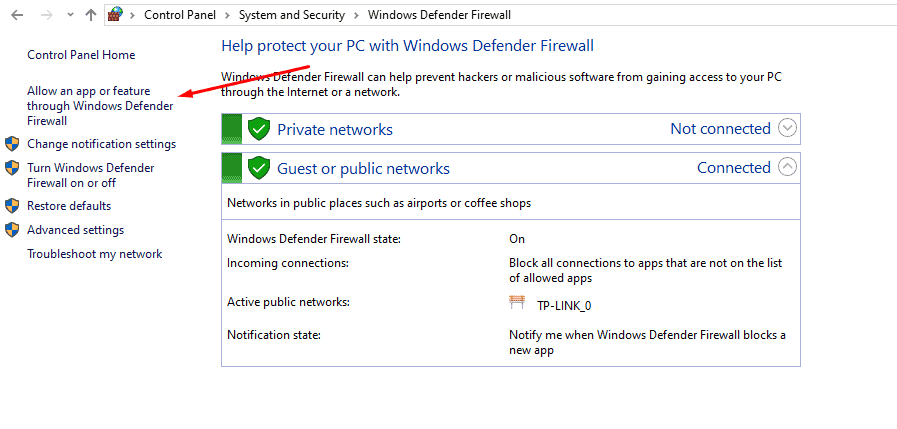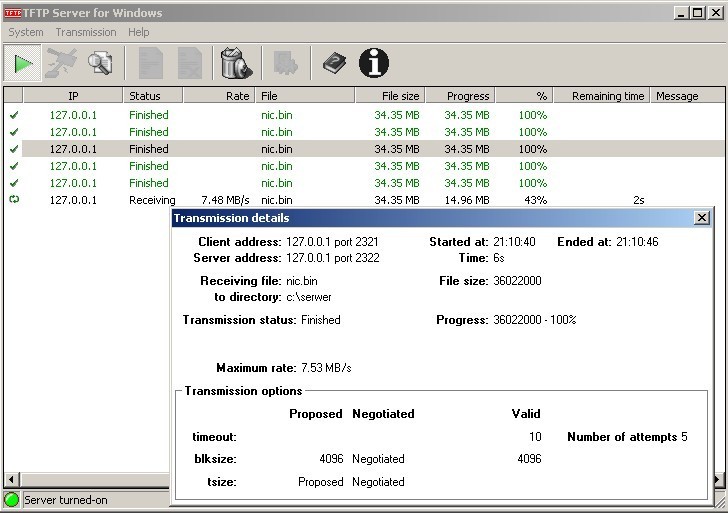
So this tells me its not the firewall and if I don't see return packets with tcpdump its something in between, perhaps maybe the application itself. Not that this may help, but I was curious to see if in fact I saw related packets coming and and leaving the firewall. Iptables: Applying firewall rules: iptables-restore v1.4.7: unknown option `-sport' A OUTPUT -sport 1024: -dport 1024: -m state -state ESTABLISHED,RELATED -j ACCEPT A INPUT -sport 1024: -dport 1024: -m state -state ESTABLISHED -j ACCEPT I have also added the following into iptables but iptables is not happy. A INPUT -p udp -m udp -dport 69 -m state -state NEW,ESTABLISHED - j ACCEPTĪlso, I have disables iptables and still get the same transfer timed out message. A INPUT -m state -state RELATED,ESTABLISHED -j ACCEPT Other things I have tried.ģ) And as you can see I already have verbose logging turned on for tftpĤ) Changing the user in the config = FAIL 2 root root 4096 Jul 26 12:17 tftpbootĪnd world has read on the files inside. World has RX on the tftpboot lib]# ll | grep tftp*ĭrwxr-xr-x.

In this article, the TFTP root directory isįile should look as shown in the screenshot below.įile with the following tftpboot]# getenforceĪnd I know the service is tftpboot]# lsof -i :69ĬOMMAND PID USER FD TYPE DEVICE SIZE/OFF NODE NAME Option is used to set the TFTP server’s root directory. Option is used to solve many of the file and directory permission issues. Option is used to allow new files to be created in the TFTP server. You have to change the lines as marked in the screenshot below.ĮxecStart=/usr/sbin/in.tftpd -s /var/lib/tftpbootĮxecStart=/usr/sbin/in.tftpd -c -p -s /var/lib/tftpboot Command firewall-cmd –reload is needed every time changing the firewall config.File is as follows. Where the –permanent option is used to permanently enable the TFTP port. # firewall-cmd –zone=public –add-service=tftp –permanent Then restart firewalld using command firewall-cmd –reload.Ī more standard way to allow TFTP is to use firewall-cmd command:
#OPEN TFTP SERVER CONFIGURE HOW TO#
See this guide to learn how to add and remove IIS Web Server on Windows Server 2019 via the Server Manager and PowerShell. Both IIS and FTP services should be installed for the configuration of the FTP server.

#OPEN TFTP SERVER CONFIGURE INSTALL#
A INPUT -m state –state NEW -m udp -p udp -m udp –dport 69 -j ACCEPT Step 1 Install Internet Information Services (IIS): FTP depends on IIS (Internet Information Services). If the TFTP write is off as shown above, enable it with setsebool command:Ībove changes to SELinux are permanent, so no need to change any SELinux config files any more.Īllow TFTP services, following line should be added to /etc/sysconfig/iptables Then check the tftp permissions in SELinux: Then reboot the system, and check SELinux status: # minimum – Modification of targeted policy. # targeted – Targeted processes are protected, # SELINUXTYPE= can take one of three two values: # disabled – No SELinux policy is loaded. # permissive – SELinux prints warnings instead of enforcing.

# enforcing – SELinux security policy is enforced. # SELINUX= can take one of these three values: # This file controls the state of SELinux on the system. To make any change to SELinux, first modify /etc/selinux/config and change the policy to permissive: By default, the SELinux uses enforcing policy, which does not accept any change. So the TFTP read and write must be allowed in SELinux. In RHEL 7.0/CentOS 7, the SELinux is not supposed to be disabled(the system will abort booting if you disable SELinux). Home]# systemctl enable home]# systemctl enable home]# systemctl start home]# systemctl start tftpĪfter these two commands, permanent links will be made for xinetd and TFTP services.


 0 kommentar(er)
0 kommentar(er)
